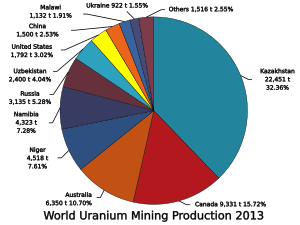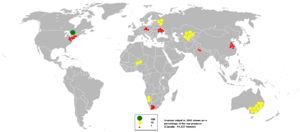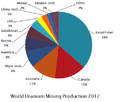Uranium mining facts for kids
Uranium mining is the process of digging up uranium ore from the ground. This ore is then processed to get the uranium out. Most of the uranium found is used as fuel for nuclear power plants, which create electricity. The top three countries that produce the most uranium are Kazakhstan, Canada, and Australia. Together, they dig up about 64% of the world's uranium.
Mining uranium can be risky for miners because of radiation. In 1990, the U.S. Congress passed a law to help people who got sick from uranium mining. The price of uranium has gone down a lot since 2011, especially after the 2011 Fukushima nuclear disaster in Japan. This means some plans for new mines have been put on hold.
Contents
What is Uranium Mining?
In 2012, about 58,000 tons of uranium were produced worldwide. Besides Kazakhstan, Canada, and Australia, other important countries that mine uranium include Niger, Namibia, Russia, Uzbekistan, the United States, China, and Malawi.
After uranium ore is dug up, it's usually ground into a fine powder. Then, chemicals are used to pull the uranium out of the powder. This process is called chemical leaching. The final product is a dry yellow powder called "yellowcake". This yellowcake is what is sold and used as fuel for nuclear power plants.
Safety and the Environment
Mining uranium can expose workers to a gas called radon, which can be harmful. In 1950, a study in the U.S. looked at the health of uranium miners. By 1962, this study showed a link between uranium mining and certain types of cancer. Because of this, the government set rules for how much radon could be in mines starting in 1969.
There are many old uranium processing sites in the U.S. Some of these sites have been left empty and are now managed by the U.S. Department of Energy. Sometimes, accidents happen at these sites. For example, in 1979, there was a large spill at a uranium mill in New Mexico. This was one of the biggest accidents involving nuclear waste in U.S. history. Another accident happened in Oklahoma in 1986.
To help people affected by uranium mining, the U.S. Congress passed a law in 1990 called the Radiation Exposure Compensation Act (RECA). This law provided money to people who got sick from mining. The law was updated in 2000 to make it even better.
Uranium Prices and Mines
The price of uranium has been quite low since July 2014. It dropped by more than half since 2011. This happened partly because Japan needed less uranium after the 2011 Fukushima nuclear disaster.
Because prices are low, some mining companies have changed their plans. For example, in February 2014, a company called Cameco decided to delay plans to dig more uranium from its mines in Canada. However, they kept working on opening a new mine. Also in February 2014, another company, Paladin Energy, stopped mining at its site in Malawi. They said it was too expensive to keep mining there when prices were so low.
Images for kids
-
The Mi Vida uranium mine, near Moab, Utah. You can see alternating red and white/green sandstone. This type of uranium is easier to mine because it's found closer to the surface.







